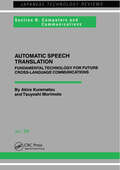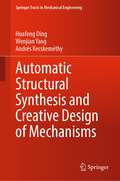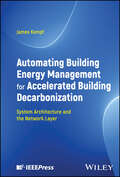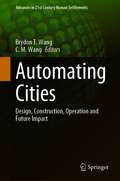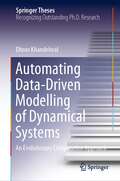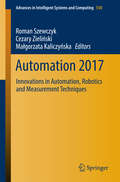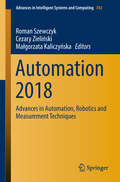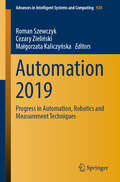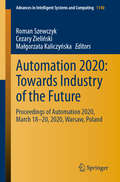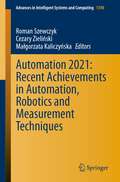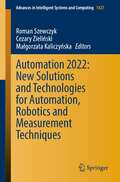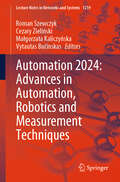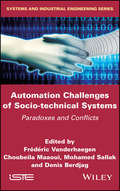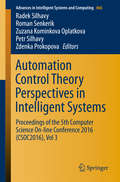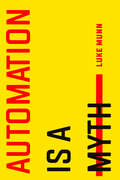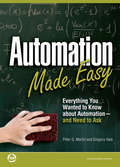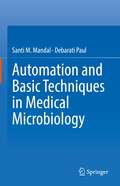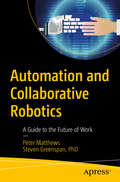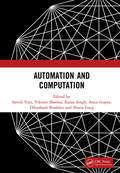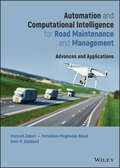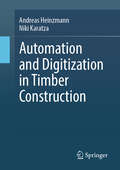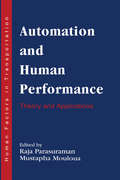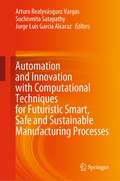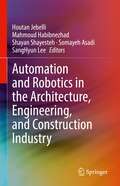- Table View
- List View
Automatic Speech Translation
by Akira KurematsuAutomatic Speech Translation introduces recent results of Japanese research and development in speech translation and speech recognition. Topics covered include: fundamental concepts of speech recognition; speech pattern representation; phoneme-based HMM phoneme recognition; continuous speech recognition; speaker adaptation; speaker-independent speech recognition; utterance analysis, utterance transfer, utterance generation; contextual processing; speech synthesis and an experimental system of speech translation. This book presents the complicated technological aspects of machine translation and speech recognition, and outlines the future directions of this rapidly developing area of technology.
Automatic Structural Synthesis and Creative Design of Mechanisms (Springer Tracts in Mechanical Engineering)
by Andrés Kecskeméthy Huafeng Ding Wenjian YangThis book provides a comprehensive overview of the current research status and open problems in the field of structural synthesis, based on which a systematic methodology for the structural analysis of planar kinematic chains, structural synthesis of planar kinematic chains, and creative design of mechanisms is presented.The method presented in this book not only promotes the development of theoretical research in the field of mechanical science, and the development of industrial software for the creative design of mechanisms, but also generates novel high-performance mechanisms suitable for industrial application, which can improve the work efficiency and economic benefits. This book offers theoretical guidance for students and researchers engaged in the field of mechanical engineering, especially the creative design of mechanism.
Automating Building Energy Management for Accelerated Building Decarbonization: System Architecture and the Network Layer
by James KempfComplete, up-to-date reference on system architecture for building energy management systems Automating Building Energy Management for Accelerated Building Decarbonization delivers detailed technical information on building energy management control technology and guidelines to implementing and deploying building energy management systems. The book provides a detailed look at the system architecture of cloud-based building energy management systems, and a comprehensive review of technology for the networking layer, from the link layer through the application layer. Wired and wireless link layer protocols, and Internet network layer protocols from the TCP/IP suite are thoroughly reviewed, and discussed in the context of deploying an in-building, operational technology network. At the application layer, BACnet, for large commercial and government buildings, and Bluetooth Low Energy, Zigbee, and Matter, for smaller commercial and residential buildings, are discussed in detail, with focus on energy management and building decarbonization. The API standards OpenAPI 3.1 and AsyncAPI 3.0 are used to define example APIs for controlling an HVAC system, illustrating how to provide API abstractions that simplify the development of building energy management applications and services. Finally, a discussion of controlling onsite distributed energy resources, such as solar panels and on-site battery storage, through SunSpec Modbus, and communicating with the utility through OpenADR and IEEE 2030.5 provide a solid technical foundation for implementing communication services in demand response and flexible load applications. Security is emphasized as a key property for the operational technology networks that run building energy systems up and down the stack. At the architectural level, security functions including data origin authentication, confidentiality protection, and key exchange are discussed in detail. Detailed information on security protocols including IPsec at the network layer, TLS at the transport layer, and Oauth2.0 at the application layer is presented. In addition, advice on deploying security solutions in building energy management networks is provided. Throughout the book, QR codes provide access to short videos about topics where more depth is needed or that are only briefly covered. These allow the reader to view more information about important topics. Automating Building Energy Management for Accelerated Building Decarbonization is an essential resource for managers, engineers, and other professionals involved in designing and building energy management services for commercial and residential buildings. It is also an excellent reference for university and training courses related to building decarbonization and renewable energy.
Automating Cities: Design, Construction, Operation and Future Impact (Advances in 21st Century Human Settlements)
by C. M. Wang Brydon T. WangThis book highlights the latest advancements in the use of automated systems in the design, construction, operation and future of the built environment and its occupants. It considers how the use of automated decision-making frameworks, artificial intelligence and other technologies of automation are presently impacting the practice of architects, engineers, project managers and contractors, and articulates the near future changes to workflows, legal frameworks and the wider AEC industry. This book surveys and compiles the use of city apps, robots that operate buildings and fabricate structural elements, 3D printing, drones, sensors, algorithms, and advanced prefabricated modules. The book also contributes to the growing literature on smart cities, and explores the impacts on data privacy and data sovereignty that arise through the use of sensors, digital twins and intelligent transport systems. It provides a useful reference for further research and development in the area of automation in design and construction to architects, engineers, project managers, superintendents and construction lawyers, contractors, policy makers, and students.
Automating Data-Driven Modelling of Dynamical Systems: An Evolutionary Computation Approach (Springer Theses)
by Dhruv KhandelwalThis book describes a user-friendly, evolutionary algorithms-based framework for estimating data-driven models for a wide class of dynamical systems, including linear and nonlinear ones. The methodology addresses the problem of automating the process of estimating data-driven models from a user’s perspective. By combining elementary building blocks, it learns the dynamic relations governing the system from data, giving model estimates with various trade-offs, e.g. between complexity and accuracy. The evaluation of the method on a set of academic, benchmark and real-word problems is reported in detail. Overall, the book offers a state-of-the-art review on the problem of nonlinear model estimation and automated model selection for dynamical systems, reporting on a significant scientific advance that will pave the way to increasing automation in system identification.
Automation 2017: Innovations in Automation, Robotics and Measurement Techniques (Advances in Intelligent Systems and Computing #550)
by Roman Szewczyk Małgorzata Kaliczyńska Cezary ZielińskiThis book consists of papers presented at Automation 2017, an international conference held in Warsaw from March 15 to 17, 2017. It discusses research findings associated with the concepts behind INDUSTRY 4. 0, with a focus on offering a better understanding of and promoting participation in the Fourth Industrial Revolution. Each chapter presents a detailed analysis of a specific technical problem, in most cases followed by a numerical analysis, simulation and description of the results of implementing the solution in a real-world context. The theoretical results, practical solutions and guidelines presented are valuable for both researchers working in the area of engineering sciences and practitioners looking for solutions to industrial problems.
Automation 2018: Advances In Automation, Robotics And Measurement Techniques (Advances In Intelligent Systems And Computing #743)
by Roman Szewczyk Małgorzata Kaliczyńska Cezary ZielińskiThis book consists of papers presented at Automation 2018, an international conference held in Warsaw from March 21 to 23, 2018. It discusses the radical technological changes occurring due to the INDUSTRY 4.0, with a focus on offering a better understanding of the Fourth Industrial Revolution. Each chapter presents a detailed analysis of interdisciplinary knowledge, numerical modeling and simulation as well as the application of cyber-physical systems, where information technology and physical devices create synergic systems leading to unprecedented efficiency. The theoretical results, practical solutions and guidelines presented are valuable for both researchers working in the area of engineering sciences and practitioners looking for solutions to industrial problems.
Automation 2019: Progress in Automation, Robotics and Measurement Techniques (Advances in Intelligent Systems and Computing #920)
by Roman Szewczyk Małgorzata Kaliczyńska Cezary ZielińskiThis book consists of papers presented at AUTOMATION2019, an international conference held in Warsaw from March 27 to 29, 2019. It discusses the radical technological changes occurring due to the INDUSTRY 4.0. To follow these changes, both scientists and engineers have to face the challenge of interdisciplinary approach directed at the development of cyber-physical systems. This approach encompasses interdisciplinary theoretical knowledge, numerical modelling and simulation as well as application of artificial intelligence techniques. Both software and physical devices are composed into systems that will increase production efficiency and resource savings. The theoretical results, practical solutions and guidelines presented are valuable for both researchers working in the area of engineering sciences and practitioners looking for solutions to industrial problems.
Automation 2020: Proceedings of Automation 2020, March 18–20, 2020, Warsaw, Poland (Advances in Intelligent Systems and Computing #1140)
by Roman Szewczyk Małgorzata Kaliczyńska Cezary ZielińskiThis book presents the scientific outcomes of the International Conference AUTOMATION 2020, held on March 18–20, 2020 in Warsaw, Poland. The next 30 years will see radical innovations in production processes, transportation management and social life. The changes brought about by the transformation to zero-emission industry require advances in many fields, but especially in industrial automation, robotics and measurement techniques associated with the cyber-physical systems employing artificial intelligence that will be key to reducing costs and enabling European society to maintain its quality of live. In this context, the book features the latest research toward further developing these fields of engineering, and also offers solutions and guidelines that are useful for both researchers and engineers addressing problems associated with the world of ongoing radical changes.
Automation 2021: Recent Achievements in Automation, Robotics and Measurement Techniques (Advances in Intelligent Systems and Computing #1390)
by Roman Szewczyk Małgorzata Kaliczyńska Cezary ZielińskiThis book contains 38 papers authored by both scientists and practitioners focused on an interdisciplinary approach to the development of cyber-physical systems. Recently our civilization has been facing one of the most severe challenges in modern history. The COVID-19 pandemic devastated the global economy and significantly disrupted numerous areas of economic activity. Only radical increase of efficiency and versatility of industrial production, with further limitation of human involvement, paralleled by the decrease of environmental burden, will enable us to cope with such challenges. We hope that the presented book provides input to the solution of at least some problems brought about by this challenge. This approach relies on the development of measuring techniques, robotic and mechatronic systems, industrial automation, numerical modeling and simulation as well as application of artificial intelligence techniques required by the transformation leading to Industry 4.0.
Automation 2022: New Solutions and Technologies for Automation, Robotics and Measurement Techniques (Advances in Intelligent Systems and Computing #1427)
by Roman Szewczyk Małgorzata Kaliczyńska Cezary ZielińskiThis book presents the unique result of discussion among interdisciplinary specialists facing recent industrial and economic challenges. It contains papers authored by both scientists and practitioners focused on an interdisciplinary approach to developing measuring techniques, robotic and mechatronic systems, industrial automation, numerical modelling and simulation, and application of artificial intelligence techniques required by the transformation leading to Industry 4.0. We strongly believe that the solutions and guidelines presented in this book will be useful to both researchers and engineers facing problems associated with developing cyber-physical systems for global development.
Automation 2024: Advances in Automation, Robotics and Measurement Techniques (Lecture Notes in Networks and Systems #1219)
by Roman Szewczyk Małgorzata Kaliczyńska Cezary Zieliński Vytautas BučinskasThis book presents the result of the most recent discussion among interdisciplinary specialists facing scientific and industrial challenges. The papers presented during the Automation 2024 Conference deal with applying artificial neural networks and other machine learning methods in perception, modelling, and control, utilization of fractional order systems, and novel sensors and measurement techniques. Recent developments in robotics and the quality of exerted control and optimization are also prominent in this volume. Specific aspects of the design of diverse robots and their modelling and control are described in depth. We strongly believe that the solutions and guidelines presented in this book will be useful to both researchers and engineers during the development of automation, robotics, and measurement systems in a rapidly changing global industry.
Automation Challenges of Socio-technical Systems: Paradoxes and Conflicts
by Mohamed Sallak Frédéric Vanderhaegen Choubeila Maaoui Denis BerdjagThe challenges of automating socio-technical systems are strongly linked to the strengths and limitations of technical and human resources, such as perceptual characteristics, cooperative capacities, job-sharing arrangements, modeling of human behavior and the contribution of innovative design approaches. Automation Challenges of Socio-technical Systems exposes the difficulties in implementing and sustaining symbiosis between humans and machines in both the short and long terms. Furthermore, it presents innovative solutions for achieving such symbiosis, drawing on skills from cognitive sciences, engineering sciences and the social sciences. It is aimed at researchers, academics and engineers in these fields.
Automation Control Theory Perspectives in Intelligent Systems: Proceedings of the 5th Computer Science On-line Conference 2016 (CSOC2016), Vol 3 (Advances in Intelligent Systems and Computing #466)
by Radek Silhavy Roman Senkerik Zuzana Kominkova Oplatkova Petr Silhavy Zdenka ProkopovaThe volume Automation Control Theory Perspectives in Intelligent Systems presents new approaches and methods to real-world problems, and in particular, exploratory research that describes novel approaches in the field of cybernetics and automation control theory. Particular emphasis is laid on modern trends in intelligent information technology, system monitoring and proactive management of complex objects The 5th Computer Science On-line Conference (CSOC2016) is intended to provide an international forum for discussions on the latest high-quality research results in all areas related to Computer Science. The addressed topics are the theoretical aspects and applications of Computer Science, Artificial Intelligences, Cybernetics, Automation Control Theory and Software Engineering.
Automation Is a Myth
by Luke MunnFor some, automation will usher in a labor-free utopia; for others, it signals a disastrous age-to-come. Yet whether seen as dream or nightmare, automation, argues Munn, is ultimately a fable that rests on a set of triple fictions. There is the myth of full autonomy, claiming that machines will take over production and supplant humans. But far from being self-acting, technical solutions are piecemeal; their support and maintenance reveals the immense human labor behind "autonomous" processes. There is the myth of universal automation, with technologies framed as a desituated force sweeping the globe. But this fiction ignores the social, cultural, and geographical forces that shape technologies at a local level. And, there is the myth of automating everyone, the generic figure of "the human" at the heart of automation claims. But labor is socially stratified and so automation's fallout will be highly uneven, falling heavier on some (immigrants, people of color, women) than others. Munn moves from machine minders in China to warehouse pickers in the United States to explore the ways that new technologies do (and don't) reconfigure labor. Combining this rich array of human stories with insights from media and cultural studies, Munn points to a more nuanced, localized, and racialized understanding of the "future of work."
Automation Made Easy: Everything You Wanted to Know about Automation-and Need to Ask
by Peter G. Martin Gregory HaleAfter a quick glance at the plant floor, it is very easy to see the industrial automation industry interoperates with other functions within the enterprise. Trying to keep up with changing technologies, however, is never easy and the industrial automation environment is no exception. Whether you are a student just starting out or are a top-level executive or manager well-versed in one domain, but have limited knowledge of the industrial automation industry, it's easy to find yourself adrift in this evolving industry. That is where this easy-to-read book comes in; it provides a basic functional understanding in the field of industrial automation. In an effort to understand this industry, the authors break down the barriers and confusion surrounding the technical details and terminology used in this converging field. They provide an introductory-level approach, covering most of the major industrial automation topics, such as distributed control systems (DCSs), programmable logic controllers (PLCs), manufacturing execution systems (MESs), and so on. You may even learn a recipe or two. This book is ideal for executives, business managers, information technologists, accountants, maintenance professionals, operators, production planners, just to name a few, and provides an in-depth but easy overview for people new to the field who want to quickly educate themselves.
Automation and Basic Techniques in Medical Microbiology
by Santi M. Mandal Debarati PaulThis book discusses principles, methodology, and applications of microbiological laboratory techniques . It lays special emphasis on the use of various automated machines that are essential for medical microbiology and diagnostic labs. The book contains eleven major chapters. The first chapter describes the good lab practices which should be followed by the students in all biological, chemistry or microbiology laboratories. The next chapter describes manual and automated characterization of antibiotic resistant microbes, followed by a chapter on genomics based tools and techniques that are integral to research. Further chapters deal with other important techniques like immunology based techniques, spectrophotometry and its various types, MALDI-TOFF and microarrays, each with illustrations and detailed description of the protocols and applications. The book also gives certain important guidelines to the students about the planning the experiment and interpreting results.The book is highly informative and provides latest techniques. It is a handy compendium for graduate and post graduate students, as well as more advanced researchers.
Automation and Collaborative Robotics: A Guide to the Future of Work
by Peter Matthews Steven GreenspanUnderstand the current and future research into technologies that underpin the increasing capabilities of automation technologies and their impact on the working world of the future.Rapid advances in automation and robotics technologies are often reported in the trade and general media, often relying on scary headlines such as “Jobs Lost to Robots.” It is certainly true that work will change with the advent of smarter and faster automated workers; however, the scope and scale of the changes is still unknown. Automation may seem to be here already, but we are only at the early stages. Automation and Collaborative Robotics explores the output of current research projects that are improving the building blocks of an automated world. Research into collaborative robotics (cobotics) is merging digital, audio, and visual data to generate a commonly held view between cobots and their human collaborators. Low-power machine learning at the edge of the network can deliver decision making on cobots or to their manipulations. Topics covered in this book include: Robotic process automation, chatbots, and their impact in the near futureThe hype of automation and headlines leading to concerns over the future of workComponent technologies that are still in the research labsFoundational technologies and collaboration that will enable many tasks to be automated with human workers being re-skilled and displaced rather than replaced What You Will Learn Be aware of the technologies currently being researched to improve or deliver automationUnderstand the impact of robotics, other automation technologies, and the impact of AI on automationGet an idea of how far we are from implementation of an automated futureKnow what work will look like in the future with the deployment of these technologies Who This Book Is For Technical and business managers interested in the future of automation and robotics, and the impact it will have on their organizations, customers, and the business world in general
Automation and Computation: Proceedings of the International Conference on Automation and Computation, (AutoCom 2022), Dehradun, India
by Karan Singh Amit Gupta Satvik Vats Sharma Vikrant Dibyahash Bordoloi Navin GargThe proceedings of the International Conference on Automation and Computation 2022 (AUTOCOM-22) consist of complete research articles that were presented at the conference. Each of the research articles was double-blind reviewed by the experts of the corresponding domain. The book contains a blend of problems and respective solutions related to computer-based automation & computation to highlight the recent technological developments in computer-based automation. It serves as an environment for researchers to showcase the latest research results on Data Science & Engineering, Computing Technologies, Computational Intelligence, Communication & Networking, Signal & Image Processing, Intelligent Control Systems & Optimization, Robotics and Automation, Power, Energy & Power Electronics, Healthcare & Computation, AI for human interaction, etc. It aims to give deep insight into the current trends of research in science and technology and shall introduce the reader to the new problems and respective approaches toward the solution and shall enlighten the researchers, students and academicians about the research being carried out in the field.
Automation and Computational Intelligence for Road Maintenance and Management: Advances and Applications
by Amir H. Gandomi Hamzeh Zakeri Fereidoon Moghadas NejadAutomation and Computational Intelligence for Road Maintenance and Management A comprehensive computational intelligence toolbox for solving problems in infrastructure management In Automation and Computational Intelligence for Road Maintenance and Management, a team of accomplished researchers delivers an incisive reference that covers the latest developments in computer technology infrastructure management. The book contains an overview of foundational and emerging technologies and methods in both automation and computational intelligence, as well as detailed presentations of specific methodologies. The distinguished authors emphasize the most recent advances in the maintenance and management of infrastructure robotics, automated inspection, remote sensing, and the applications of new and emerging computing technologies, including artificial intelligence, evolutionary computing, fuzzy logic, genetic algorithms, knowledge discovery and engineering, and more. Automation and Computational Intelligence for Road Maintenance and Management explores a universal synthesis of the cutting edge in parameters and indices to evaluate models. It also includes: Thorough introductions to management science and the latest methods of automation and the structure and framework of automation and computing intelligence Comprehensive explorations of advanced image processing techniques, recent advances in fuzzy, and diagnosis automation Practical discussions of segmentation and fragmentation and different types of features and feature extraction methods In-depth examinations of methods of classification along with various developed methodologies and models of quantification, evaluation, and indexing in automation Perfect for postgraduate students in road and transportation engineering, evaluation, and assessment, Automation and Computational Intelligence for Road Maintenance and Management will also earn a place in the libraries of researchers interested in or working with the evaluation and assessment of infrastructure.
Automation and Digitization in Timber Construction
by Andreas Heinzmann Niki KaratzaIn this work, the authors provide an overview of the manufacturing principles possible in timber construction, such as batch, line, and cell production, and assess these approaches in relation to the requirements of different timber construction companies. In a further step, technological possibilities for all relevant processes in timber construction production are discussed. Due to the authors' strong ties to science and research, the technological approaches are analyzed for their potential strengths and weaknesses, offering the reader a neutral perspective, independent of manufacturer arguments. The authors not only address key questions that arise regarding new construction or expansion of production, but also present solutions that help optimize and digitize the entire process, from order generation to the completion of a construction project. A central guiding principle of the authors is the realization that optimizing a single area in production cannot fully harness the potential of the entire timber construction process.
Automation and Human Performance: Theory and Applications (Human Factors In Transportation Ser.)
by Raja Parasuraman and Mustapha MoulouaThere is perhaps no facet of modern society where the influence of computer automation has not been felt. Flight management systems for pilots, diagnostic and surgical aids for physicians, navigational displays for drivers, and decision-aiding systems for air-traffic controllers, represent only a few of the numerous domains in which powerful new automation technologies have been introduced. The benefits that have been reaped from this technological revolution have been many. At the same time, automation has not always worked as planned by designers, and many problems have arisen--from minor inefficiencies of operation to large-scale, catastrophic accidents. Understanding how humans interact with automation is vital for the successful design of new automated systems that are both safe and efficient. The influence of automation technology on human performance has often been investigated in a fragmentary, isolated manner, with investigators conducting disconnected studies in different domains. There has been little contact between these endeavors, although principles gleaned from one domain may have implications for another. Also, with a few exceptions, the research has tended to be empirical and only theory-driven. In recent years, however, various groups of investigators have begun to examine human performance in automated systems in general and to develop theories of human interaction with automation technology. This book presents the current theories and assesses the impact of automation on different aspects of human performance. Both basic and applied research is presented to highlight the general principles of human-computer interaction in several domains where automation technologies are widely implemented. The major premise is that a broad-based, theory-driven approach will have significant implications for the effective design of both current and future automation technologies. This volume will be of considerable value to researchers in human
Automation and Human Solidarity
by Bill JordanThis book provides a detailed analysis of the economic and political implications of the introduction of Artificial Intelligence and Robotics into the service sector of economies that have so far relied on service jobs to sustain levels of employment. It examines how reliance on coercive measures for enforcing low-paid service work attempts to postpone this third Industrial Revolution, and analyses the struggles that must still take place if we are to achieve a future of freedom and social justice for all. While automation and globalisation have made human solidarities of traditional kinds more difficult to sustain, they have also made new kinds possible. Experiments in social policy, and especially the pilot projects with unconditional Universal Basic Incomes, offer a possible model for a new kind of society. The author argues that it is politics which will determine whether we can achieve these new human solidarities.
Automation and Innovation with Computational Techniques for Futuristic Smart, Safe and Sustainable Manufacturing Processes
by Arturo Realyvásquez Vargas Jorge Luis García Alcaraz Suchismita SatapathyThis book explores sustainability and innovation in manufacturing, encompassing three distinct parts. The first section delves into Sustainability in Manufacturing, where it analyzes topics like intelligent manufacturing, Industry 4.0 challenges, structural equation modeling for social sustainability, barriers to intelligent manufacturing systems, and critical success factors in Six Sigma deployment. The second part of the book, comprising Chapters 6-11, focuses on Ergonomics and Safety in manufacturing, examining cases related to health issues caused by factors like noise, high-temperature working conditions, ergonomic posture, and design attributes for ergonomic products. Lastly, Part III, consisting of Chapters 12-14, explores computational techniques applied in manufacturing, addressing issues such as vegetable waste in India, technology transfer models for university-industry collaboration, and the application of System Dynamics in safety management systems. Together, these chapters provide a comprehensive overview of sustainability, ergonomics, safety, and computational techniques in the manufacturing industry.
Automation and Robotics in the Architecture, Engineering, and Construction Industry
by Somayeh Asadi Houtan Jebelli Mahmoud Habibnezhad Shayan Shayesteh SangHyun LeeAutomation and Robotics in the Architecture, Engineering, and Construction Industry provides distinct and unified insight into current and future construction robotics, offering readers a comprehensive perspective for constructing a road map and illuminating improvements for a successful transition towards construction robotization. The book covers the fundamentals and applications of robotics, autonomous vehicles, and human-perceptive machines at construction sites. Through theoretical and experimental analyses, it examines the potential of robotics and automated systems for current and future fieldwork operations and identifies the factors that determine their implementation pace, adoption scale, and ubiquity throughout the industry. The book evaluates the technical, societal, and economic aspects of adopting robots in construction, both as standalone and collaborative systems, which in return can afford the opportunity to investigate these AI-enabled machines more systematically.
